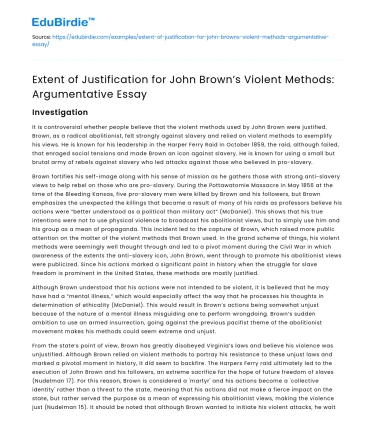Investigation
It is controversial whether people believe that the violent methods used by John Brown were justified. Brown, as a radical abolitionist, felt strongly against slavery and relied on violent methods to exemplify his views. He is known for his leadership in the Harper Ferry Raid in October 1859, the raid, although failed, that enraged social tensions and made Brown an icon against slavery. He is known for using a small but brutal army of rebels against slavery who led attacks against those who believed in pro-slavery.
Brown fortifies his self-image along with his sense of mission as he gathers those with strong anti-slavery views to help rebel on those who are pro-slavery. During the Pottawatomie Massacre in May 1856 at the time of the Bleeding Kansas, five pro-slavery men were killed by Brown and his followers, but Brown emphasizes the unexpected the killings that became a result of many of his raids as professors believe his actions were “better understood as a political than military act” (McDaniel). This shows that his true intentions were not to use physical violence to broadcast his abolitionist views, but to simply use him and his group as a mean of propaganda. This incident led to the capture of Brown, which raised more public attention on the matter of the violent methods that Brown used. In the grand scheme of things, his violent methods were seemingly well thought through and led to a pivot moment during the Civil War in which awareness of the extents the anti-slavery icon, John Brown, went through to promote his abolitionist views were publicized. Since his actions marked a significant point in history when the struggle for slave freedom is prominent in the United States, these methods are mostly justified.
Save your time!
We can take care of your essay
- Proper editing and formatting
- Free revision, title page, and bibliography
- Flexible prices and money-back guarantee
Although Brown understood that his actions were not intended to be violent, it is believed that he may have had a “mental illness,” which would especially affect the way that he processes his thoughts in determination of ethicality (McDaniel). This would result in Brown’s actions being somewhat unjust because of the nature of a mental illness misguiding one to perform wrongdoing. Brown’s sudden ambition to use an armed insurrection, going against the previous pacifist theme of the abolitionist movement makes his methods could seem extreme and unjust.
From the state’s point of view, Brown has greatly disobeyed Virginia’s laws and believe his violence was unjustified. Although Brown relied on violent methods to portray his resistance to these unjust laws and marked a pivotal moment in history, it did seem to backfire. The Harpers Ferry raid ultimately led to the execution of John Brown and his followers, an extreme sacrifice for the hope of future freedom of slaves (Nudelman 17). For this reason, Brown is considered a 'martyr' and his actions become a 'collective identity' rather than a threat to the state, meaning that his actions did not make a fierce impact on the state, but rather served the purpose as a mean of expressing his abolitionist views, making the violence just (Nudelman 15). It should be noted that although Brown wanted to initiate his violent attacks, he waited until an opportunity broke open for him to utilize, which is when the shooting of Charles Dow, a believer of “free soil” from Ohio took place (Gilpin 20). Since the shooting, the disagreeable factions began to sharply add upon their methods of expressing views with the use of violence. Brown did not join right away, but once he found out that the “Free Soil” men were “thoroughly determined to fight” and just needed a leader, he could not resist the offer (Gilpin 16). Although Brown did not necessarily initiate the first violent shooting, his following perceived violence as a necessary means of propaganda to promote their views.
Despite John Brown’s strong belief that slavery was unjust, others may view that no matter what, the use of violence, especially in Brown’s case, is not justified. Since his violent acts were not for self-defense, but rather as a way of getting revenge upon slave owners, many believe that his acts are unjust. In Brown’s case, he and his followers practically started the acts of violence with the first attacks at Pottawatomie Creek, Kansas against the pro-slavery residents to the later years after raising funds where he initiated an attack on slaveholders during the Harpers Ferry (Toledo 107). Although the initiated attacks by Brown were seemingly unnecessary since slavery did not directly affect him, nor has he ever been affected by it, he believed strongly in other’s rights and did not believe that it was just for slaveholders to continue their supposed abusive treatment to these poor slaves. His aim was to “create a southern portal for the Underground Railway,” referring to a path of freedom for the slaves to follow once escaped after the raid, going against the Fugitive Slave Act of 1850 ('Brown's Raid Changed World;'). This rebellion, yet seemingly unjust in its methods from the outside perspective, seemed to be the only method that he could develop to help dramatically publicize the abolitionist views of anti-slavery, therefore justifying his methods.
Overall, the violent methods insisted by John Brown were mostly justified because of the life sacrifices made to promote his abolitionist views to the public. In addition, he did not intend for violence to characterize and lead his raids at first, but quickly realized that pacifism would not suffice in marking a pivotal moment in abolitionist history. Although some viewed that his methods were unjust due to its violent nature, Brown disagrees, while the opposing and contradicting views that resulted in his execution served as a means of anti-slavery propaganda itself.






 Stuck on your essay?
Stuck on your essay?

